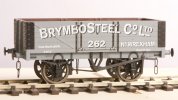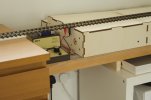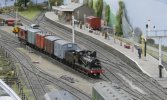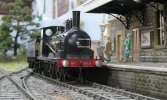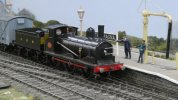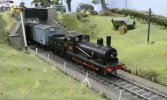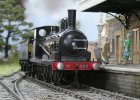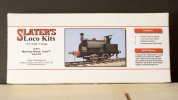
I bought the kit for the MW class F in November last year, when I felt the Y14 was going to work out okay. I am hoping this kit is a sensible progression for me. It is my first loco with outside cylinders, first with suspension, first with sprung wire pickups, and first with a two-stage gearbox.
It is also my first brass kit for any coach, wagon or loco not created by Connoisseur Models; and so my first without Jim’s marvellous instructions and a first without the unwritten but frequently re-quoted words, “they go together”. Slater’s have few loco kits on their web site but this one has the year 1985 on its etches, and even the name of the designer too. Their wagon kits are good, so I can be optimistic.
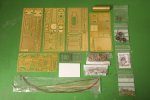
There are four etches for the body from 0.4 mm brass, one for the chassis from 0.5 mm brass and one for the side rods from steel. There are alternate parts for different cabs and spectacle plates and one of the etches is devoted to an enclosed cab. The parts are numbered on the etches, which looks good, but I see numbers 1 to 6 at least are used twice, perhaps not so good.
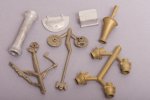
The detail castings are of a very good standard so if they fit I should be able to build a good-looking model. I am guessing the metals here are pewter as well as white metal and brass. Nice touches include turned steel buffer heads (though I might take these for my GER van) and plenty of spare half-etched holes to practise embossing rivets. The boiler has been machined as a brass cylinder and will need work to open up space for the motor.
I have stumbled upon an essay on these locos in MRJ number 6, and gone on to find their magazine project to build the loco from scratch in 4 mm scale. I could never cope with the intricacy in the smaller scale, but in 7 mm I think I have a chance.
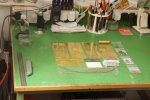
The bench is rarely anywhere near this tidy!
I have made a modest start on the frames but the current September heatwave makes it far too hot to do much more. Hopefully an update next weekend.
Contents
1. Lower Firebox and Ashpan (page 47)
2. Frames and Attachments for Brakes
3. Front Suspension
4. Crossheads and Connecting Rods (page 48)
5. Gearbox and Motor
6. Rear Crankpins
7. Front Crankpins
8. Cylinders (page 49)
9. Front Splashers
10. Design Features for Superstructure
11. Cab Sides and Coal Bunkers
12. Cab Back (page 50)
13. Running Plate
14. Boiler
15. Saddle Tank
16. Cab, Brake Standard and Steps
17. Springs and Sand Boxes
18. Smokebox
19. Underpinnings (page 51)
20. Clack Valves
21. Chimney
22. Firebox (page 53)
23. Reverser Reach Rod (page 55)
24. Motor Mount
25. Brake Gear
26. Test Running (1): 9V Battery; and Control Decisions
27. Battery Bracket (page 56)
28. Injector (page 57)
29. Choosing the On/Off Switch and a Fuse
30. Saddle Tank (completion)
31. Test Running (2): Radio Control (page 58)
32. Sanding Gear
33. Test Running (3): Endurance
34. Cab Roof (omitted)
35. Dismantling and Snagging
36. Battery Charging Connector (page 59)


